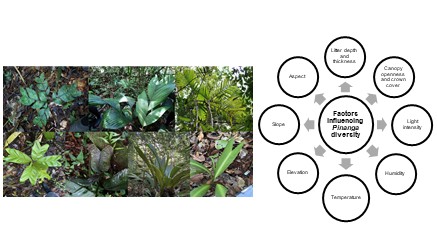PHYTOTOXICITY AND FIELD EFFICACY OF EXSEROHILUM LONGIROSTRA JC/MIN THE CONTROL OF BARNYARDGRASS ECOTYPES (ECHINOCHLOA CRUS-GALLI VAR. CRUS-GALLI(L.) BEAUV)
No. 24 (2005)
Research Paper
November 17, 2011
Downloads
Malaysia and Indonesia were tested for their susceptibility to the potential bioherbicide (Exserohilum longirostratum).
Bamyardgrass seedlings at the 2-3-lcaf stage were treated with 2.5xl07
conidia/ml from E. longirostratum at different
application frequencies (single, double and triple). In addition, aqueous extract assays were evaluated for the presence of a
phytotoxic compound responsible for the virulence of the bioherbicide. Results of the study showed that disease severity
significantly increased 20 days after treatment and resulted in mortality of the seedlings. Ecotypes from Perak and
Lampung were most susceptible to the bioherbicide upon triple applications. Percentage dry weight reductions were
86.34 and 83.14%, respectively. Other ecotypes (Melaka, Banten and South Sulawesi) were observed to have a relatively
similar response. Moreover, aqueous extracts of E. longirostratum increased mortality up to 92.50% of bamyardgrass
seedlings. These findings suggest that regular (double and triple) applications of E. longirostratum at a concentration of
2.5xl07
 conidia/ml significantly increased mortality among bamyardgrass ecotypes. Mortality of the seedlings was
attributed to the presence of a secondary phytotoxic metabolite.
Key words :Â Â Â Field efficacy / Phytotoxicity / Exserohilum longirostratum I Echinochloa crus-galli var. crusgalli I ecotypes.
JURAIMI, A. S., TASRIF, A., KADIR, J., NAPIS, S., & SASTROUTOMO, S. S. (2011). PHYTOTOXICITY AND FIELD EFFICACY OF EXSEROHILUM LONGIROSTRA JC/MIN THE CONTROL OF BARNYARDGRASS ECOTYPES (ECHINOCHLOA CRUS-GALLI VAR. CRUS-GALLI(L.) BEAUV). BIOTROPIA, (24). https://doi.org/10.11598/btb.2005.0.24.172
Downloads
Download data is not yet available.
Authors who publish with this journal agree with the following terms:
- Authors retain copyright and grant the journal right of first publication, with the work 1 year after publication simultaneously licensed under a Creative Commons attribution-noncommerical-noderivates 4.0 International License that allows others to share, copy and redistribute the work in any medium or format, but only where the use is for non-commercial purposes and an acknowledgement of the work's authorship and initial publication in this journal is mentioned.
- Authors are able to enter into separate, additional contractual arrangements for the non-exclusive distribution of the journal's published version of the work (e.g., post it to an institutional repository or publish it in a book), with an acknowledgement of its initial publication in this journal.
- Authors are permitted and encouraged to post their work online (e.g., in institutional repositories or on their website) prior to and during the submission process, as it can lead to productive exchanges, as well as earlier and greater citation of published work (See The Effect of Open Access).


























